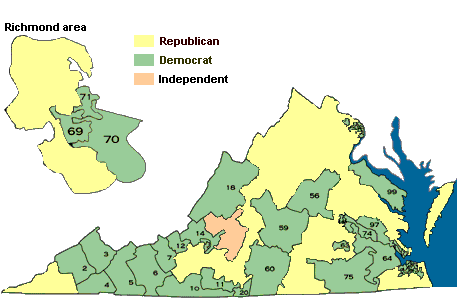 Statewide |
||
|---|---|---|
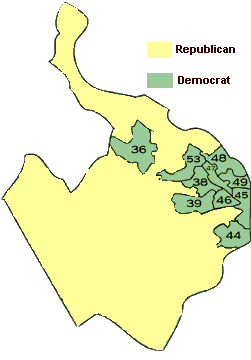 Northern Virginia |
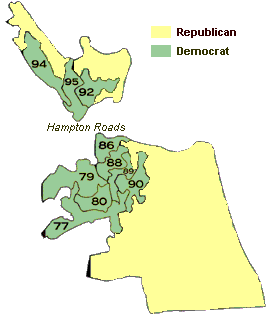 Tidewater |
|
 Statewide |
||
|---|---|---|
 Northern Virginia |
 Tidewater |
|
In the November 2, 1999 election, the Republican Party won control of the House of Delegates for the sessions in 2000-2001. However, the victories were not evenly spread across the state. As shown in the maps below:
When power is divided so evenly, each member can gain or retain influence by a threat to bolt and join the other party. In November 1999, State Senator Warren Barry, the Republican representing the 37th State Senate District in Fairfax, contributed substantial funds to his son's campaign for sheriff of Fairfax County. His son upset the incumbent, Carl Peed, a Republican incumbent.
However, threats to strip Barry of his chairmanship in the State Senate, in retaliation for supporting a Democrat, were quashed quickly.1
The political realities of trying to govern with a slim majority require political leaders to emphasize compromise more than partisan purity. Otherwise, a less-than-perfect majority can quickly slip into a far-from-power minority...
So consider the challenge facing the political strategists of each party. Virginia's population is increasingly urban/suburban; the days of farmers controlling state government through the Byrd Organization/Machine are long gone. One party could gamble and adopt a "suburban strategy," shaping its political stands to appeal to those voters concerned about the impacts of growth. If the demographic statistics indicate the suburban fringe and Edge Cities are where the voters are increasing.... why not develop a political platform that appeals to concerns of those residents?
Of the 100 elections in November, 1999, however, only 5 seats (5% of the total) switched parties. The next set of maps (below) show that all four districts that switched from Democrat to Republican in the 1999 election have dynamically-changing populations. Places with a large percentage of new residents are places where incumbents have a smaller advantage, and therefore good opportunities for challengers to win. In fast-growing counties like Loudoun and Fluvanna, it is possible that a majority of voters in the 2003 election (two terms away for a delegate, but the next election cycle for State Senator) will not have been residents of the county in 1999.
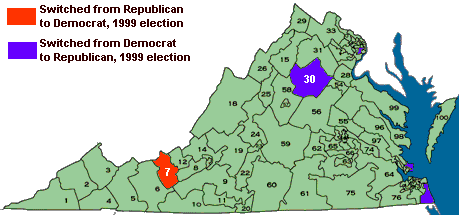
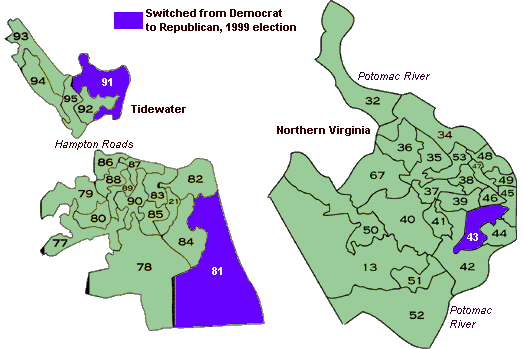
However, it's equally possible that rural districts hold the balance of power in Virginia today. Their population may not be growing, but representatives from "cow country" can still determine whether Republicans or Democrats are in charge. If so, then support for new school construction, mass transit, gun control, and land use constraints on sprawl might alienate voters in those rural counties with little or no growth, and even less desire for state taxes to steer development to the fringes or the center of the cities. So politicians for both parties are no longer willing to "write off" any region in the state, as the Byrd Machine once treated the cities.
Typically, a challenger needs extensive support from the political party that has endorsed them in order to win a seat in the House of Delegates. In the 91st District, each candidate spent nearly $500,000 during the 1999 campaign. That was a million-dollar campaign for a job that pays $18,000/year.
Virginia has no term limits on legislators - the governor, however, is restricted to serving one term - and turnover in the House membership is usually small. In January, 2000, 92% of the delegates were incumbents returning to serve a new term. Of the eight new delegates, only two defeated the previous incumbent. The other six new members won races with an "open" seat, where the incumbent did not run in the fall election. Of the new delegates, only 11 had been in a contest where they won by less than 10%:
| House District |
Democratic votes |
Republican votes |
Total votes |
winning percentage |
|---|---|---|---|---|
| 84 | 5,122 | 6,347 | 11,493 | 55.22% |
| 86 | 2,672 | 2,171 | 4,849 | 55.10% |
| 7 | 7,873 | 5,274 | 14,794 | 53.22% |
| 99 | 10,174 | 8,975 | 19,183 | 53.04% |
| 43 | 6,612 | 7,230 | 13,851 | 52.20% |
| 94 | 7,037 | 5,985 | 13,504 | 52.11% |
| 81 | 4,922 | 5,295 | 10,232 | 51.75% |
| 67 | 7,004 | 7,413 | 14,443 | 51.33% |
| 44 | 7,065 | 6,726 | 13,798 | 51.20% |
| 30 | 6,897 | 9,172 | 18,118 | 50.62% |
| 90 | 4,735 | 4,025 | 9,477 | 49.96% |
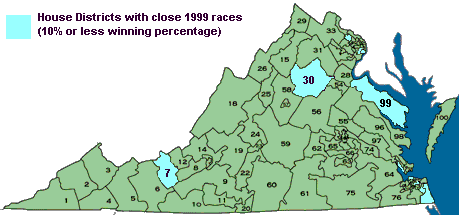
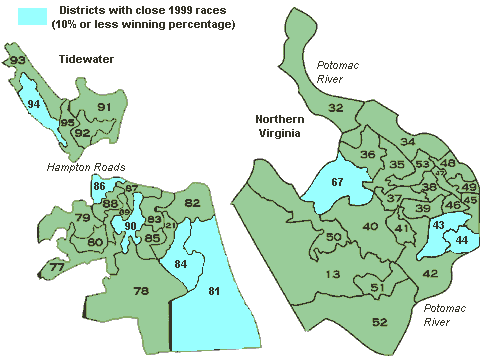
So when the General Assembly redrew the boundaries of the districts after the 2000 Census, particular districts received special attention. The political strategists in charge (Republicans who took control of the General Assembly in 1999...) sought to add Republican precincts to those districts which were competitive in 1999.
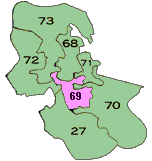
69th District - Richmond
If Democratic precincts are moved into districts where those votes won't help in a close election, then Republicans will lose a few elections by a landslide. In 1999, Richmond's 69th District was an example of this concentration of Democrats. Only 2,849 people even bothered to vote in 1999; 99.7% voted for the Democratic incumbent, Frank Hall. There was no Republican candidate - Hall has served in the House since 1976 - but there were 9 write-in votes.

14th District - Roanoke area
In contrast, the vigorous campaign for the 14th District in the Roanoke area attracted the largest number of voters in a House race in 1999. The race there had been close in 1997, but in 1999 Richard Cranwell - leader of the Democratic Party in the House - retained his seat by winning over 63% of the 21,206 votes.
By concentrating Democrats into a few districts thoroughly dominated by one party, the Republicans could then win most of the close contests, elect a majority of delegates that exceeds their percentage of the statewide vote totals, and retain control of the House for 10 years.
With 48-49% of the votes, one party could elect 52-53% of the delegates if the district boundaries were drawn just right. It make sense to spend $1 million in the campaign for the 91st District, because much more was at stake than just one seat in the House.
The Democrats did partisan redistricting after the 1990 Census, but it was not enough to block the rise of the Republicans in the 1990's. However, the artfully-drawn boundaries may have delayed the change in power by 2-4 years.
Governor George Allen anticipated the power shift would occur as early as 1995, and invested considerable political capital in campaigning for Republican challengers. When the Democrats retained control of the General Assembly throughout his term, the personal reactions of the Democratic victors to his efforts to defeat them did not make governing easier.
From the Washington Post in 2013:2